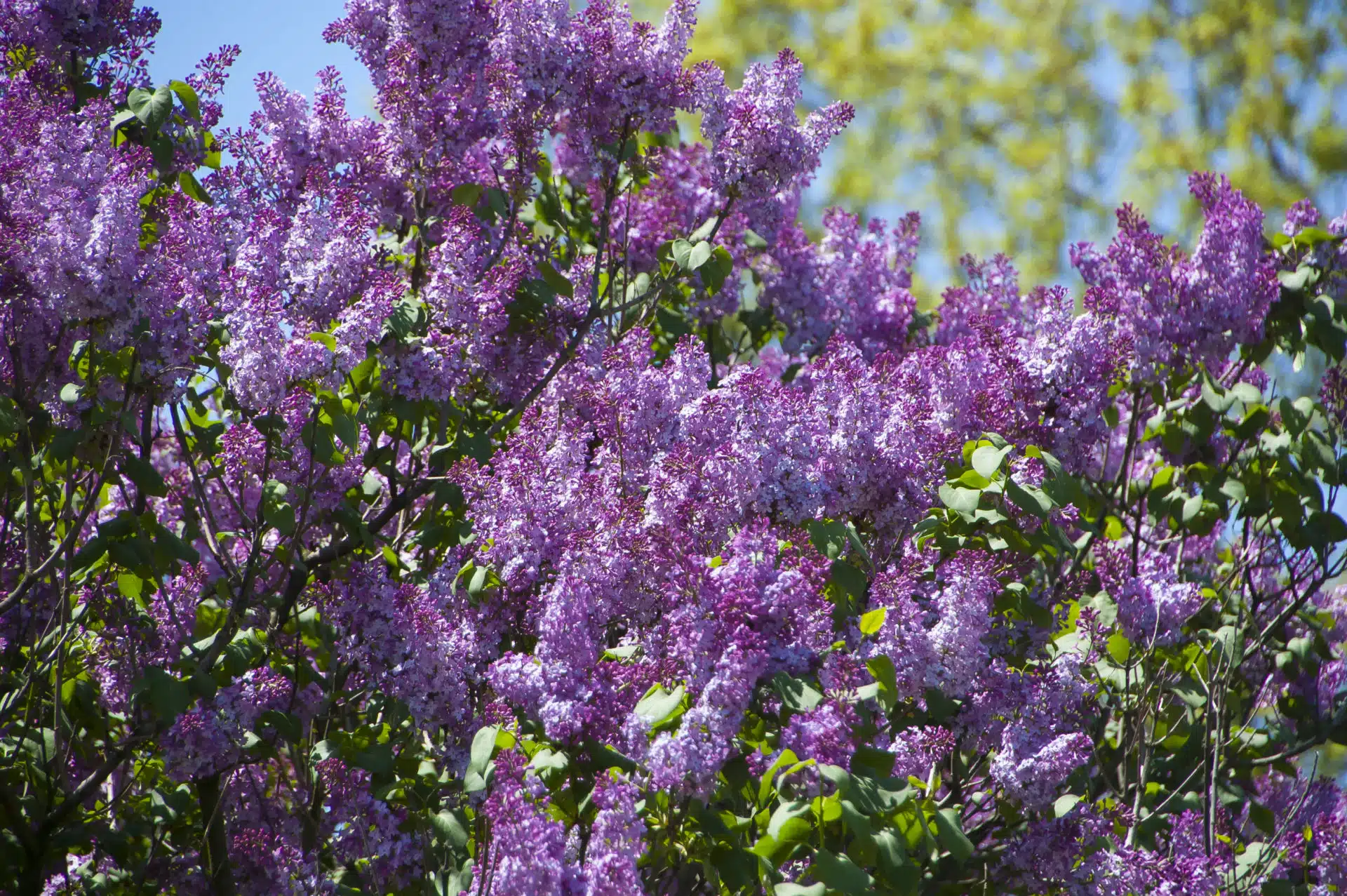Plants
Common lilac
Syringa vulgaris

Native to the Balkans in southeastern Europe, Syringa vulgaris (common lilac) is a member of the olive family (Oleaceae), which also includes Fraxinus (ash), Chionanthus (fringe tree), Ligustrum (privet), and Forsythia. Of the 21 species of lilacs in the world, two are native to Europe and the rest to Asia. Among these, the common lilac is the most fragrant and sought after. It has been cherished in gardens and as a cut flower for more than 500 years. In the Display Garden of The Holden Arboretum, there are currently 106 common lilac plants including 87 cultivars. Cultivated varieties of Syringa vulgaris are known and loved for their beauty, fragrance and dependability. Planting of the lilac collection started in 1939 including five common lilacs that still grace the Display Garden. To the northeast of Lotus Pond is an outstanding lilac named Syringa vulgaris ‘Albert F. Holden’ that has fragrant single purple florets with silvery outer edges as they open, making for a dazzling display. Nearby is ‘Atheline Wilbur’ that has fragrant double pale magenta florets. These lilacs were bred and named for the arboretum’s founder and the wife of board member John Wilbur by John Fiala of Medina, Ohio, who authored an excellent book on lilacs.
The Lemoine family of France bred and introduced more than 200 lilacs from the late 19th to early 20th centuries. These, also known as French lilacs, are still among the finest available in commerce. There are 45 Syringa vulgaris cultivars originating from the Lemoine nursery in our collection. Two good examples in the Display Garden are Syringa vulgaris ‘Émile Lemoine’ on the south side, which has fragrant double lilac florets and ‘Cavour’, to the north adjacent to the footbridge, which has fragrant single violet florets.
These and other common lilacs bloom for around three weeks at the Arboretum. The flowering time is very temperature dependent, with April 19 being the earliest and May 15 being the latest start of bloom recorded in the past 10 years. Hybrids of common lilac and the early lilac, Syringa oblata of eastern Asia, typically bloom a week to 10 days earlier, with a few flowers opening as early as March 26 in 2012. These hyacinth lilacs, Syringa x hyacinthiflora, are otherwise very similar to common lilacs by all appearances. There are 33 hyacinth lilacs, including 24 cultivars in the Display Garden. Occasionally flowers of both the common and hyacinth lilacs will be damaged by spring frosts as happened during the Easter freeze of 2007.
Lilacs can grow quite tall – ‘Miss Ellen Willmott’ was 20 feet in 2014. The average height for our common lilacs that are at least 15 years old is just over 13 feet. The lilacs at the arboretum have been pruned with older stems removed that are less floriferous and likely to become infested with borers. Such pruning rejuvenates older lilacs as most readily grow new stems from their base. Plants not growing well are usually either not getting enough sun, or are in soil that is not well-drained or fertile. Since lilacs prefer a neutral soil pH, incorporating limestone to the planting bed, in addition to composted organic matter, can help plants flourish. Lilacs are very sensitive to herbicides. Even if weeds are sprayed nearby, the “drift” can cause significant damage to prized specimens. I became keenly aware of this in 1981 when the foreman of the Display Garden pointed out to me distorted leaves on lilacs adjacent to weeds I had previously sprayed with Roundup. Herbicides used to control broad-leaved weeds in lawns can also damage or kill lilacs that have roots in a lawn. Syringa vulgaris ‘Miss Ellen Willmott’ also showcases the variations in fragrance to be found with lilacs, which are often associated with a pleasant scent. The plant has beautiful white flowers, but not fragrance. In addition, the fragrance of the lilac flowers can be stronger or milder on the same plant from year to year.
The handsome foliage of lilacs can be marred in the summer by powdery mildew, which can be unsightly but not harmful to the plant. While some cultivars are more resistant to mildew than others, even ‘Dwight D. Eisenhower’ had a slight case of mildew in 2000 when the surrounding trees began to shade it too much, and it was removed in 2013. Seed pods are often borne on common lilacs, but less frequently on the double-flowered varieties. I have not yet noticed any spontaneous seedlings of common lilac in the Display Garden.
At my home in Willoughby is Syringa vulgaris ‘Edith Braun’ which was bred by John Rankin of Elyria, Ohio, and named after his fiancée, who died before they were married. ‘Edith Braun’ has wonderfully fragrant single magenta-purple flowers that are also appreciated by my neighbor whose garden shed it is near. Although deer will browse lilacs, it is not their preferred food, at least not at the Arboretum. Good companion plants for lilacs can be found in the Display Garden, including deer-resistant herbaceous peonies and tree peonies. Trees that have flowers complementary to lilacs include Magnolia ‘Yellow Bird’, the dogwood blight resistant Cornus florida ‘Appalachian Spring’, and the red buckeye (Aesculus pavia).
Come out to the Arboretum in May and enjoy the lilacs. There will be an opportunity starting this spring for volunteers to participate in a study that ranks lilac fragrance. If you have a good nose for this sort of thing look for notice in an upcoming issue of Holden’s Tree-mail newsletter from Robin Ott, our volunteer coordinator.




